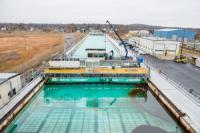-
U.S. companies performed 18 percent of R&D outside the United States
U.S. companies spent $73 billion on research and development (R&D) performed outside the United States in 2013, according to a new report by the National Science Foundation’s National Center for Science and Engineering Statistics. The total represented 18 percent of U.S. companies’ total R&D performance. These same companies spent $323 billion on R&D performed within the United States in 2013. Four industries accounted for 52 percent of foreign R&D performance by U.S. companies.
-
-
Sustainability’s threat to fossil fuel industry is only going to increase
Commercial activity in fossil fuels is increasingly at odds with global actions to reduce the threat of climate change. Burning coal, oil, and natural gas is responsible for two-thirds of humanity’s emissions of greenhouse gases, and yet provides more than 20 percent of GDP in two dozen nation states. By Citicorp’s estimate, current commitments to reduce these emissions could mean forgoing $100 trillion in fossil fuel revenues by 2050 — representing a huge disruption to global affairs, undermining national budgets and corporate balance sheets while exposing stakeholders, including pension holders and ordinary citizens in resource-exporting states, to myriad risks.
-
-
Bee colonies-inspired tool to help dismantle terrorist cells, criminal social networks
Researchers have designed an algorithm, inspired by the intelligent and social behavior of bee colonies, which allows law enforcement to attack and dismantle any type of social network that poses a threat, whether physical or virtual, such as social networks linked to organized crime and jihadist terrorism. The possible applications of this new bio-inspired algorithm, which helps to make optimal decisions in order to dismantle any type of social network, are many and varied: from dismantling a criminal network to facilitating the design of vaccination strategies capable of containing the spread of a pandemic.
-
-
Latest science on sea level rise projections: In support of California policy guidance
An estimated 75 percent of California’s population lives in coastal counties. Sea-level rise, already underway, threatens hundreds of miles of roads and railways, harbors, airports, power plants, wastewater treatment plants, coastal wetlands, beaches, dunes, bluffs, and thousands of businesses and homes. In a comprehensive analysis of the factors that affect how much the ocean will rise along California’s coast in coming decades, a seven-member team of experts has provided the state with a report on the best-available sea-level rise science — including recent scientific advances on the role of polar ice loss.
-
-
Cities inland could be reshaped by migration from sea-level rise
When Hurricane Katrina struck Louisiana in 2005, cities inland saw an influx of evacuees escaping the storm and its aftermath. Now, a new study predicts that this could happen again as a result of sea-level rise. Researchers estimate that approximately 13.1 million people could be displaced by rising ocean waters, with Atlanta, Houston, and Phoenix as top destinations for those forced to relocate. The study is the first attempt to model the destination of millions of potentially displaced migrants from heavily populated coastal communities.
-
-
Soil-based scrubber turns deadly chemicals into harmless dirt
A DARPA program that is developing a field-deployable system for onsite neutralization of bulk stores of chemical warfare agents (CWA) has successfully demonstrated a novel waterless soil-scrubbing technology that safely neutralized toxic chemicals simulating sarin, soman, and mustard agents. The technology demonstrated greater than 99.9999 percent removal of the simulants, without creating any hazardous waste by-products.
-
-
Risk and Reliance: Mineral resources and the U.S. economy
In 1954 the United States was fully reliant on foreign sources for only eight mineral commodities. In 2016, the United States was fully reliant on foreign sources for twenty mineral commodities, including rare earth elements, manganese, and niobium. This is a 250 percent increase in sixty years. China is the single largest source of mineral commodities for the United States, particularly for resources like rare earth elements, germanium, and industrial diamonds. Of the 47 mineral commodities that the United States is more than 50 percent reliant on foreign sources, 24 came in part from China.
-
-
Climate change: Less impact on drought than previously expected
As a multiyear drought grinds on in the Southwestern United States, many wonder about the impact of global climate change on more frequent and longer dry spells. As humans emit more carbon dioxide into the atmosphere, how will water supply for people, farms, and forests be affected? Reduced precipitation will increase droughts across southern North America, southern Europe and northeastern South America. But the results show that in Central Africa and temperate Asia—including China, the Middle East, East Asia and most of Russia—water conservation by plants will largely counteract the parching due to climate change.
-
-
Space technology identifies land degradation in West Africa
Researchers map regional droughts from space which can affect the livelihood of millions of people in West Africa. Soil moisture observations can map land degradation with more accuracy than typical rainfall data as soil moisture directly leads to plant growth. Study shows that the land conditions across much of West Africa have improved between 1982 and2012 based on soil moisture observations.
-
-
Glowing bacteria detect buried landmines, unexploded ordnance

About half a million people around the world are suffering from mine-inflicted injuries, and each year an additional 15 to 20 thousand more people are injured or killed by these devices. More than 100 million such devices are still buried in over seventy countries. The major technical challenge in clearing minefields is detecting the mines. Researchers have developed a potential answer to this urgent need: a novel, functional system combining lasers and bacteria to remotely map the location of buried landmines and unexploded ordnance.
-
-
New training course on understanding, preventing radicalization, violent extremism
Practitioners and civic actors including law enforcement officers, school officials and community leaders can now, through a new self-paced, online training, gain a better understanding of radicalization to violence and violent extremism in the United States. Made available at no cost to learners, thanks to funding from the DHS, the course will also introduce a broad spectrum of community-led activities intended to foster resilience and counter violent extremism.
-
-
Hack-resistant hardware

Military and civilian technological systems, from fighter aircraft to networked household appliances, are becoming ever more dependent upon software systems inherently vulnerable to electronic intruders. DARPA has advanced a number of technologies to make software more secure. But what if hardware could be recruited to do a bigger share of that work? That’s the question DARPA’s new System Security Integrated Through Hardware and Firmware (SSITH) program aims to answer.
-
-
New resilience study helps governments prevent disaster-related loss
Hurricanes, wildfires, tsunamis, and other disasters cannot be stopped, but countries can plan for them — something some areas of the world seem to do better than others, according to a new study. In the study, thirty-eight factors that affect a country’s resilience were derived from national and international databases, and the researchers used these databases to grade the resilience of each country and continent and develop a comprehensive index that includes indicators such as the number of disasters and their death tolls, as well as an area’s population, infrastructure, economy and educational system.
-
-
Super sponge effectively removes toxins from lakes

Mercury is very toxic and can cause long-term health damage, but removing it from water is challenging. To address this growing problem. Researchers have created a sponge that can absorb mercury from a polluted water source within seconds. The sponge converts the contamination into a non-toxic complex so it can be disposed of in a landfill after use. The sponge also kills bacterial and fungal microbes.
-
-
Reusable sponge soaks up oil, revolutionizes oil spill, diesel cleanup

When the Deepwater Horizon drilling pipe blew out seven years ago, beginning the worst oil spill in U.S. history, those in charge of the recovery discovered a new wrinkle: the millions of gallons of oil bubbling from the sea floor weren’t all collecting on the surface where it could be skimmed or burned. Some of it was forming a plume and drifting through the ocean under the surface. Now, scientists have invented a new foam, called Oleo Sponge, that addresses this problem. The material not only easily absorbs oil from water, but is also reusable and can pull dispersed oil from the entire water column—not just the surface.
-
More headlines
The long view
New Technology is Keeping the Skies Safe
DHS S&T Baggage, Cargo, and People Screening (BCP) Program develops state-of-the-art screening solutions to help secure airspace, communities, and borders
Factories First: Winning the Drone War Before It Starts
Wars are won by factories before they are won on the battlefield,Martin C. Feldmann writes, noting that the United States lacks the manufacturing depth for the coming drone age. Rectifying this situation “will take far more than procurement tweaks,” Feldmann writes. “It demands a national-level, wartime-scale industrial mobilization.”
How Artificial General Intelligence Could Affect the Rise and Fall of Nations
Visions for potential AGI futures: A new report from RAND aims to stimulate thinking among policymakers about possible impacts of the development of artificial general intelligence (AGI) on geopolitics and the world order.
Smaller Nuclear Reactors Spark Renewed Interest in a Once-Shunned Energy Source
In the past two years, half the states have taken action to promote nuclear power, from creating nuclear task forces to integrating nuclear into long-term energy plans.
Keeping the Lights on with Nuclear Waste: Radiochemistry Transforms Nuclear Waste into Strategic Materials
How UNLV radiochemistry is pioneering the future of energy in the Southwest by salvaging strategic materials from nuclear dumps –and making it safe.
Model Predicts Long-Term Effects of Nuclear Waste on Underground Disposal Systems
The simulations matched results from an underground lab experiment in Switzerland, suggesting modeling could be used to validate the safety of nuclear disposal sites.
